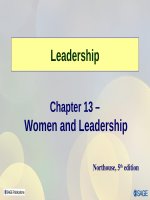Organization theory and design: Lecture 13
Bạn đang xem bản rút gọn của tài liệu. Xem và tải ngay bản đầy đủ của tài liệu tại đây (22.05 KB, 7 trang )
Inter-organization Relationships
•
•
•
•
•
13
Organizational Ecosystems
Resource Dependence
Collaborative Networks
Population Ecology
Institutionalism
1
Organizational Ecosystems
• An organizational ecosystem is a system formed by the
interaction of a community of organizations and their
environment.
• The concept of co-evolution (competition dead)
• Within business ecosystems managers learn to move
beyond traditional responsibilities of corporate strategy,
designing structures and control systems. If that
happens, company is missing opportunities for new and
evolving external relationships (suppliers and customers
becoming parts of business value chain)
• Business leaders have the responsibility to lead
economic co evolution (understanding the big picture
around them)
2
Inter-organizational Framework
•
Inter organizational relationships among
different organizations can be characterized by:
– whether the organizations are similar or dissimilar
– whether relationships are competitive or cooperative
1. dissimilar/competitive (resource dependence)
2. dissimilar/cooperative (collaboration network)
3. similar/competitive (population ecology)
4. similar/cooperative (institutionalism)
3
1. Resource Dependence
• Traditional view of inter-organizational
relationships
• Strategies to overcome resource
dependence include:
– purchasing ownership in suppliers
– joint ventures
– interlocking directorates
– trade associations
– mergers
4
2. Collaboration Networks
• As new wave of technology based on digital
communications builds, computer
manufacturers, local phone companies, cable
TV operators, cellular phone companies, and
even water and gas utilities have been teaming
up
• They share risk and enhance corporate profile
• Japan and Korea have long traditions corporate
clans or industrial groups (from adversaries to
partners)
5
3. Population Ecology
•
•
•
•
•
•
Focus is on organizational diversity and adaptation within a
population of organizations
A population is a set of organizations engaged in similar activities
with similar patterns of resource utilization and outcomes
Large organizations become dinosaurs, new organizational forms
that fit the current environment would emerge (e-business, gas
stations)
Organizational form is an organization’s specific technology,
structure, products, goals, and personnel which can be selected or
rejected by the environment
Each new organization tries to find a niche
Process of variation (large number of variations appear in the
population of organizations), selection (some organizations find a
niche and survive), retention (a few organizations grow large and
become institutionalized in the environment)
6
4. Institutionalism
• This view argues that organizations need
legitimacy from their stakeholders.
• Companies perform well when they are
perceived by the larger environment to
have a legitimate right to exist.
• The institutional view believes that
organizations adopt structures and
processes to please outsiders
(stakeholders/ society)
7









